Vintage Treasures: The Year’s Best Science Fiction, Third Annual Collection, edited by Gardner Dozois
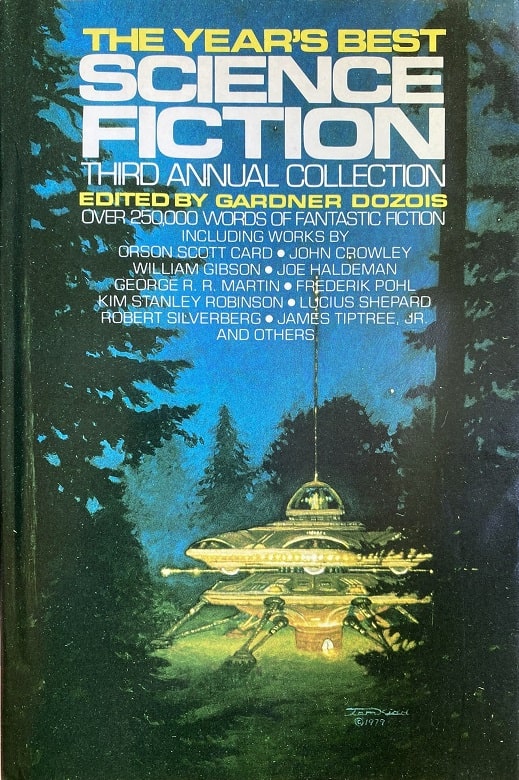 |
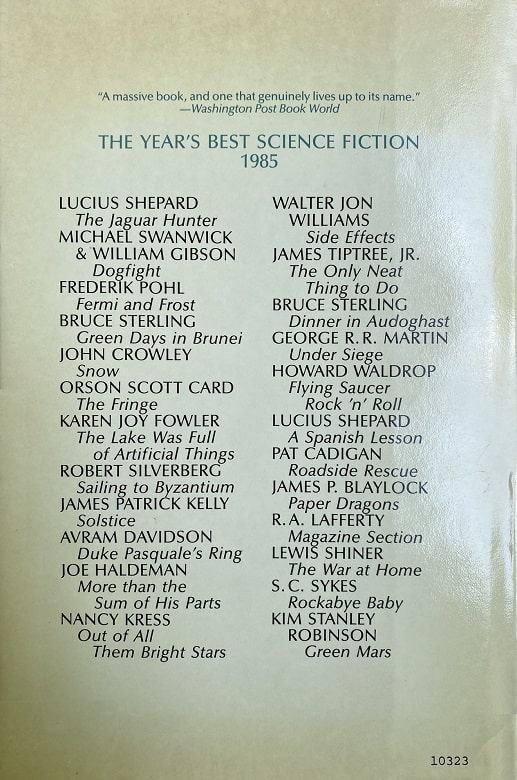 |
The Year’s Best Science Fiction, Third Annual Collection (Bluejay Books, April 1986). Cover by Tom Kidd
I saw a copy of the third volume in Gardner Dozois’ Year’s Best Science Fiction anthology series on eBay for $11.45 last week, and decided to take a chance. Turned out to be the Book Club edition, a reprint that’s a smaller size than my other volumes, which was a disappointment. But at least I finally had a copy.
On the back of the book I found a Table of Contents — and Lord, what an amazing list. Gardner had famously good taste, but this single volume includes some of the most acclaimed science fiction of the past few decades. It contains Lucius Shepard’s famous magic realist tale “The Jaguar Hunter,” a Hugo and Nebula nominee; Frederik Pohl’s Hugo winner “Fermi and Frost;” Bruce Sterling’s classic novella of an old-school bulletin-board romance, the Nebula-nominated “Green Days in Brunei;” Robert Silverberg’s Hugo-winning far-future tale “Sailing to Byzantium;” Nancy Kress’s famous Nebula Award-winning story of a waitress who meets an alien on the night shift, “Out of All Them Bright Stars;” James Tiptree, Jr’s Locus and Hugo Award-winning novella of a young woman who spends her last dollars renting a spaceship to explore the frontier, “The Only Neat Thing to Do;” Pat Cadigan’s creepy tale of alien sex on the road, “Roadside Rescue;” James P. Blaylock’s World Fantasy Award winner “Paper Dragons;” and the novella that kicked off one of the most acclaimed SF trilogies of the 20th Century, Kim Stanley Robinson’s “Green Mars.”
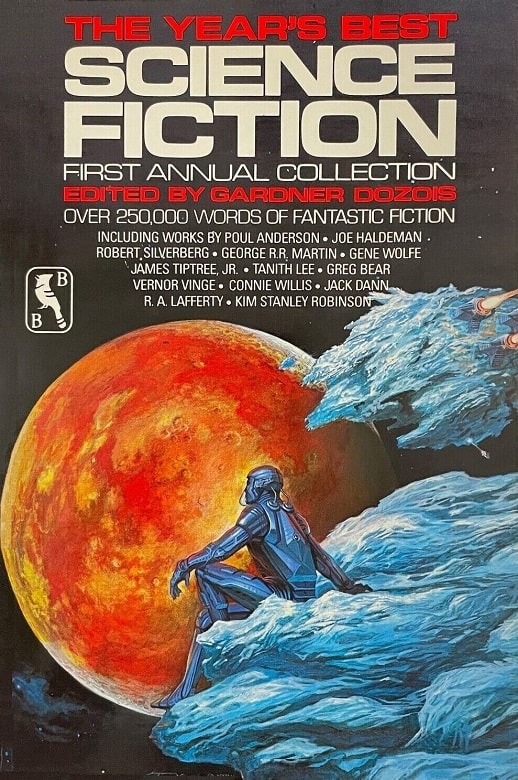 |
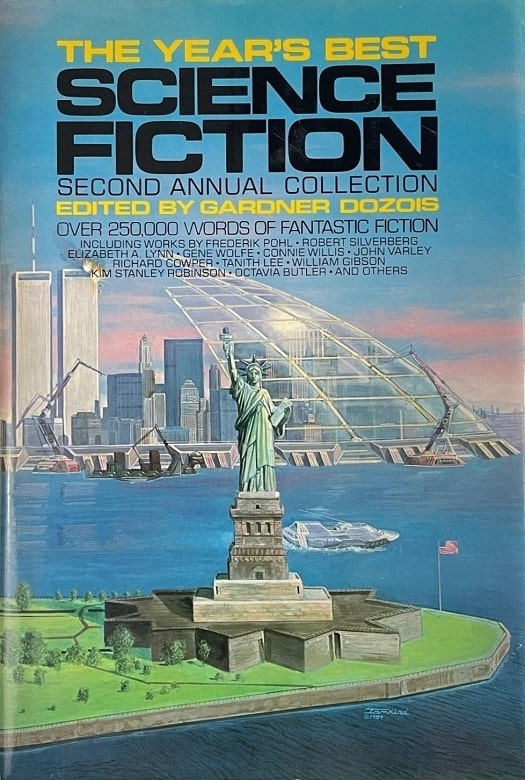 |
The Year’s Best Science Fiction, First and Second Annual Collection (Bluejay Books,
April 1984 and 1985). Covers by Tom Kidd. These are the hardest volumes to find.
The Year’s Best Science Fiction, Third Annual Collection won the Locus Award for the Best Anthology of the year, the first Dozois volume to do so. (Volume 1 came in 4th, and Volume 2 was the first runner-up in previous years.)
Many of these stories are still read and discussed today. But my favorite review is Austin Beeman’s story-by-story discussion at ShortSF.com. He summarizes the best as follows:
“Dogfight” by William Gibson and Michael Swanwick. A classic masterpiece of Cyberpunk. A small time crook becomes a master as a virtual game of airplane dogfights. He also befriends a wealthy young woman. Their lives collide in tragic ways.
“The Fringe” by Orson Scott Card. There is such humanity in Card’s work. A handicapped teacher on the frontier is terrorized by his students after he reported their criminal parents to the authorities. Raw, dangerous, human, and with some real courage and hope.
“Sailing to Byzantium” by Robert Silverberg. One of the greatest stories of the far future. A man from the 20th century is transported to far far future where people build and explore cities of the past. A wealth of lush detail, believably strange situations, and deep worth-building. This is an hypnotic epic.
“Out of All Them Bright Stars” by Nancy Kress. Brief and full of import. A waitress in a diner serves an alien, but learns a hard truth about humanity that she never wanted to know. One of those stories that transcend the genre and could be enjoyed by anyone who loves literature.
“The Only Neat Thing to Do” by James Tiptree, Jr. A young woman joyrides through space, solves a mystery, meets an alien, and has to make some very hard decisions. A fun and mysterious piece of space opera that slowly turns into something you don’t expect.
“A Spanish Lesson” by Lucius Shepard. What starts as a memoir of a bohemian life in Spain, becomes a mysterious investigation of the neighbors, and explodes to a weird tale of alternate universe Hilter and weird monsters.
“Green Mars” by Kim Stanley Robinson. This is a story of mountain climbing on Mars’ highest mountain, but there is a hell of a lot of interesting character develop going on behind the scenes. The adventure of the climb is riveting, suspenseful, and full of more thrilling detail than I thought possible. Really special stuff.
The Internet is filled with folks still discussing these stories today. Here’s Jesse’s Speculation review of “The Only Neat Thing to Do” by James Tiptree Jr.
Coati Cass is a plucky, intelligent young girl with dreams of space. She knows all the star stations, the models of ship that traverse the universe, and the rules of space flight. Saving up her money, she decides to put her knowledge to use and fulfill her dreams by renting a ship for a few weeks’ trip into the great unknown. Things go smoothly at first; she spends the last of her money on fuel and food, gets permission to lift off after chartering a course, and heads off to the starry beyond. At the first way station, however, things take a turn—as innocent as it may be. Intercepting a message from a pair of spacers thought lost, she decides to follow up on their request for help. Little does she know what else was stowed in the message container.
Opening in an adventurous mode a la Jack Vance and closing on the bleakest of notes a la Hemingway, “The Only Neat Thing to Do” is a true arc of story… Tiptree Jr. covers a lot of ground in the short, heartbreaking novella.
In the end, “The Only Neat Thing to Do” is a poignant tale of a young girl who turns herself loose on the world only to meet a tragic end. By parallel, it is also the story of an author in turmoil, seeking escape from demons past and present. The main plot device similar to Jack Vance’s Nopalgarth or Dan Simmon’s Carrion Comfort, readers will find the underlying content all Tiptree Jr.’s. Symbolism ripe and the narrative flowing, the story haunts beyond the grave.
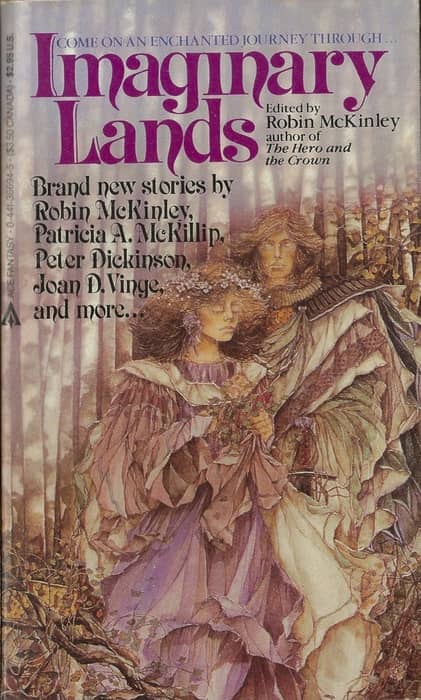 |
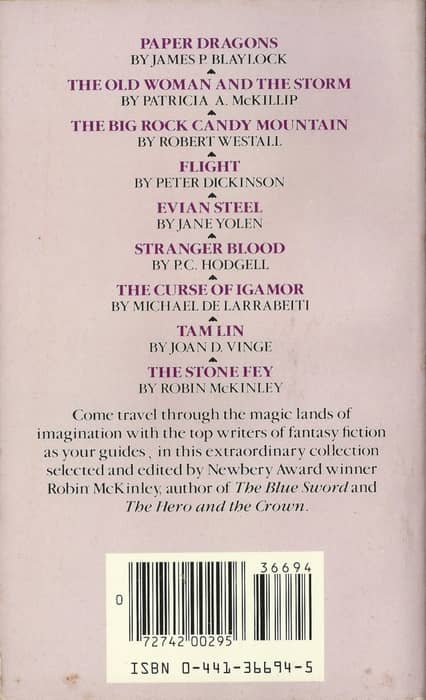 |
Imaginary Lands (Ace Books, 1985). Cover by Thomas Canty
And here’s my favorite piece on one of my favorite stories in this anthology, James P Blaylock’s lovely “Paper Dragons.”
“Paper Dragons” won the World Fantasy Award for Best Short Story in 1986. Originally published in Imaginary Lands, I have the standalone version from Axolotl Press with the intro by Blaylock’s pal Tim Powers.
The story has a lovely dream-y feel of Northern California with a lot of what makes Blaylock Blaylock. Animals behaving strangely. People behaving strangely. And the petty foibles of human society — like tossing tomato worms into a neighbor’s yard. Not much of a story, but more a prose poem on the possibility of the magical being just around the bend, or behind a passing cloud.
Read the whole article by essentialsaltes at LiveJournal.
The Year’s Best Science Fiction, Third Annual Collection contains no less than five novellas, including a Doctor Eszterhazy story by Avram Davidson and very first Mars story by Kim Stanley Robinson:
“Green Days in Brunei” by Bruce Sterling
“Sailing to Byzantium” by Robert Silverberg
“Duke Pasquale’s Ring” by Avram Davidson
“The Only Neat Thing to Do” by James Tiptree, Jr.
“Green Mars” by Kim Stanley Robinson
Here’s the complete Table of Contents.
Introduction: Summation: 1985, by Gardner Dozois
“The Jaguar Hunter” by Lucius Shepard (The Magazine of Fantasy & Science Fiction, May 1985) — Hugo, Nebula nominee
“Dogfight” by William Gibson and Michael Swanwick (Omni, July 1985) — Hugo, Nebula nominee
“Fermi and Frost” by Frederik Pohl (Isaac Asimov’s Science Fiction Magazine, January 1985) — Hugo winner, Locus Award nominee
“Green Days in Brunei” by Bruce Sterling (Isaac Asimov’s Science Fiction Magazine, October 1985) — Nebula nominee
“Snow” by John Crowley (Omni, November 1985) — Hugo, Nebula, Locus Award nominee
“The Fringe” by Orson Scott Card (The Magazine of Fantasy & Science Fiction, October 1985) — Hugo, Nebula nominee
“The Lake Was Full of Artificial Things” by Karen Joy Fowler (Isaac Asimov’s Science Fiction Magazine, October 1985)
“Sailing to Byzantium” by Robert Silverberg (Isaac Asimov’s Science Fiction Magazine, February 1985) — Locus, Nebula nominee, Hugo Award winner
“Solstice” by James Patrick Kelly (Isaac Asimov’s Science Fiction Magazine, June 1985)
“Duke Pasquale’s Ring” by Avram Davidson (Amazing Stories, May 1985)
“More Than the Sum of His Parts” by Joe Haldeman (Playboy, May 1985) — Nebula nominee
“Out of All Them Bright Stars” by Nancy Kress (The Magazine of Fantasy & Science Fiction, March 1985) — Nebula Award winner
“Side Effects” by Walter Jon Williams (The Magazine of Fantasy & Science Fiction, June 1985)
“The Only Neat Thing to Do” by James Tiptree, Jr. (The Magazine of Fantasy & Science Fiction, October 1985) — Nebula nominee; Locus and Hugo Award winner
“Dinner in Audoghast” by Bruce Sterling (Isaac Asimov’s Science Fiction Magazine, May 1985) — Hugo nominee
“Under Siege” by George R. R. Martin (Omni, October 1985)
“Flying Saucer Rock & Roll” by Howard Waldrop (Omni, January 1985) — Hugo, Nebula nominee
“A Spanish Lesson” by Lucius Shepard (The Magazine of Fantasy & Science Fiction, December 1985)
“Roadside Rescue” by Pat Cadigan (Omni, July 1985)
“Paper Dragons” by James P. Blaylock (Imaginary Lands, 1985) — Nebula nominee, World Fantasy Award winner
“Magazine Section” by R. A. Lafferty (Amazing Stories, July 1985)
“The War at Home” by Lewis Shiner (Isaac Asimov’s Science Fiction Magazine, May 1985)
“Rockabye Baby” by S. C. Sykes (Analog Science Fiction/Science Fact, Mid-December 1985) — Nebula nominee
“Green Mars” by Kim Stanley Robinson (Isaac Asimov’s Science Fiction Magazine, September 1985) — Hugo, Nebula, Locus Award nominee
Honorable Mentions: 1985
Gardner Dozois, it probably goes without saying, edited some of my favorite science fiction books. Here are a couple still on my nightstand.
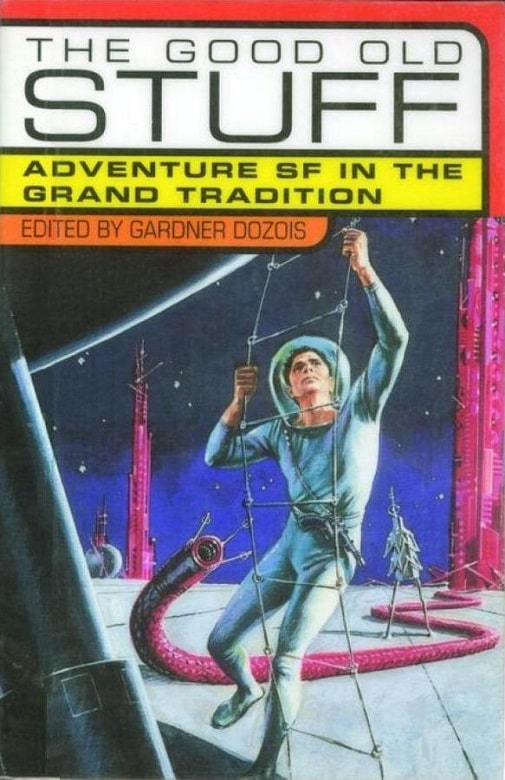 |
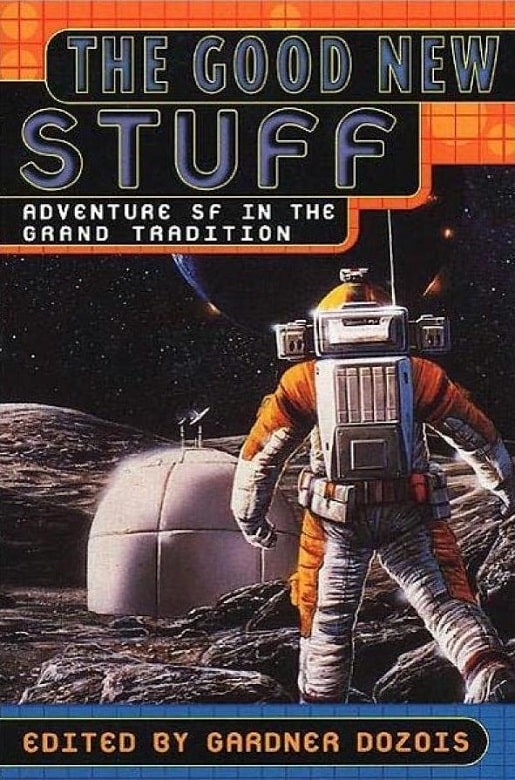 |
The Good Old Stuff and The Good New Stuff, edited by Gardner Dozois (St. Martin’s Griffin,
December 1998 and January 1999). Covers by Ed Emshwiller and Vincent Di Fate
Our previous coverage of Gardner’s many books and articles includes:
Vintage Detectives: Supernatural Sleuths, Sci-Fi Private Eye, and Isaac Asimov’s Detectives, edited By Gardner Dozois, Sheila Williams, Charles G. Waugh, and Martin H. Greenberg (March 2023)
Quatro-Decadal Review: Asimov’s Science Fiction, November 1989, by Adrian Simmons (September 2022)
The Book of Magic (October 2018)
The Book of Swords (October 2017)
Jack Dann & Gardner Dozois’ 40-Volume Reprint Library (June 2018)
Gardner Dozois, July 23, 1947 – May 27, 2018 (May, 2018)
Modern Classics of Science Fiction (December 2021)
Modern Classic Short Novels of Science Fiction (October 2021)
A Book That Makes You Yearn to be Stranded on a Desert Island: Modern Classics of Fantasy (July 2017)
A Final Gift From Gardner: The Very Best Of The Best: 35 Years Of The Year’s Best Science Fiction (July 2019)
The End of an Era: The Year’s Best Science Fiction: Thirty-Fifth Annual Collection (June 2018)
The Year’s Best Science Fiction: Thirty-Fourth Annual Collection (July 2017)
The Year’s Best Science Fiction: Thirty-Third Annual Collection (September 2016)
The Year’s Best Science Fiction: Thirty-Second Annual Collection (August 2015)
Gardner Dozois on the New Sword & Sorcery (March 2016)
Worldmakers and Supermen (February 2016)
Explorers and The Furthest Horizon (December 2015)
The Good Stuff (December 2015)
Multiverse: Exploring the Worlds of Poul Anderson, edited by Greg Bear and Gardner Dozois (June 2015)
Finding The Best: An Interview With Year’s Best Editors Ellen Datlow, Paula Guran, Rich Horton And Gardner Dozois by Bryan Thomas Schmidt (August 2013)
Gardner Dozois on the 2013 Hugo Nominations (April 2013)
Gardner also produced a number of massive best-selling anthologies co-edited with George R.R. Martin. They include:
Old Venus
Old Mars
Rogues
Warriors, reviewed by Jason M. Waltz
Songs of the Dying Earth
The Year’s Best Science Fiction, Third Annual Collection was published by Bluejay Books in April 1986. It is 624 pages, priced at $19.99 in hardcover, and $10.95 in trade paperback. There is no digital edition. The cover is by Tom Kidd.
See all our recent coverage of Gardner’s work here.
Most trivial of comments … “Green Mars” does not exactly “kick off” the Mars trilogy. It’s set in a sort of “beta version” of the final Mars books, and while it shares a title with one of the books and also some characters, it’s clearly not in the same continuity. Also, there’s an earlier story, from 1982, “Exploring Fossil Canyon”, that is similarly set in a beta version of the Mars trilogy setting.
And to further confuse the issue, Robinson’s first novel, published in 1985, ICEHENGE, is partly set on Mars, and examines some of the same themes: longevity and terraforming in particular. Apparently he wrote the first draft of it in 1977, while taking a class from Ursula K. Le Guin, and gave it to her for comments. Anyway, that could arguably be called an “alpha” version!
Rich — that’s fascinating, and I had no idea. I’ve never read Robinson’s Mars trilogy, so that’s news to me.
I did make a run at Icehenge ten years ago and found it very slow…. but it was also his first novel.